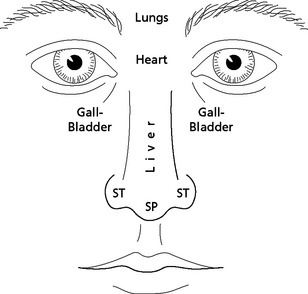Chapter 7 The patterns causing each of the nose signs discussed below are listed in greater detail in Part 5, Chapter 58. The nose is influenced primarily by the Lung channel because the Lung ‘opens’ into the nose and controls the sense of smell. Chapter 37 of the ‘Spiritual Axis’ says: ‘The nose is the sense organ of the Lungs’1 and Chapter 17 says: ‘Lung-Qi penetrates the nose, when the nose is harmonized it can smell.’2 Chapter 4 of the ‘Simple Questions’ says: ‘The West corresponds to the white colour and it is related to the Lungs which opens into the nose.’3 The Song dynasty doctor Chen Wu Ze said: ‘The nose is the orifice of the Lungs through which we breathe and smell; in the nose Yang-Qi ascends and Yin-Qi descends so that it is the passage of Clear Qi.’4 It is interesting to note that the Lung channel does not actually reach the nose and it therefore influences the nose through the Large Intestine channel. The pathways of the channels flowing through or around the nose are as follows: The channels flowing through or around the nose are illustrated in Figure 7.1. Box 7.1 summarizes the channels influencing the nose. Apart from the relationship between the nose and these channels, the shape and colour of the nose have particular diagnostic significance in facial diagnosis. In fact, pathological colours of the nose may reflect pathology of other organs such as the Liver and Spleen. Chapter 37 of the ‘Spiritual Axis’ says: ‘The Bright Hall [nose] can have five [pathological] colours reflecting the Qi of the five Yin organs.’5 Different parts of the nose are related to different organs and these are illustrated in Figure 7.2. Chapter 19 of the ‘Spiritual Axis’ says: ‘The bone of the Bright Hall [bridge of the nose] should be high, even and straight; the state of the five Yin organs can be determined from the centre of the nose, while the state of the six Yang organs from the sides.’6
 OBSERVATION OF THE NOSE
OBSERVATION OF THE NOSE
INTRODUCTION
CHANNELS INFLUENCING THE NOSE
RELATIONSHIPS BETWEEN THE NOSE AND THE INTERNAL ORGANS
![]()
Stay updated, free articles. Join our Telegram channel

Full access? Get Clinical Tree


Basicmedical Key
Fastest Basicmedical Insight Engine


